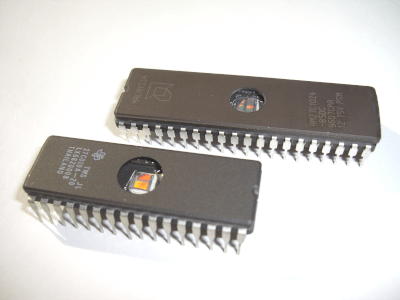What Is EPROM?

EPROM stands for “erasable programmable read-only memory” and is a semiconductor memory that can write and erase data a certain number of times.
EPROM is a nonvolatile memory that retains the content of written data even when the power is turned off. EPROM erases all data in the memory by exposing it to strong ultraviolet light for a certain period of time.
Therefore, it is not possible to erase the data, leaving only a portion of the data. In addition, it should be noted that continuous exposure to sunlight or fluorescent light over a long period of time will erase the data. Because the data can be rewritten only a few dozen times or because it takes a certain amount of time to erase data, EEPROM (electrically erasable PROMs) and flash memory, which use electricity to erase data, have been replacing EPROM in recent years.
Uses of EPROMs
EPROMs are used in computer-controlled equipment where programs and data are written to them. They can erase and write data many times but must be subjected to a UV irradiation device in order to erase the data.
When embedded in electronic equipment, EPROMs must be removed from the equipment and subjected to UV irradiation each time data is rewritten. For this reason, EEPROMs, which can rewrite data electrically, are becoming the mainstream.
Structure of EPROMs
In EPROMs, one bit of data is held in a single transistor. The transistor that holds the data is called a memory cell transistor.
The memory cell transistor in EPROMs has an electrically isolated floating gate embedded in the gate oxide film.
EPROMs consist of a grid of memory cells.
Principles of EPROMs
The principles of EPROMs are explained from three perspectives.
1. Writing Principle
By applying a high voltage to the control gate of a memory cell transistor, electrons flowing between the source and drain in the memory cell transistor channel acquire high energy. Some of the energized electrons jump over the gate oxide film and are injected into the floating gate, causing the gate to become negatively charged. When the floating gate becomes negatively charged, data has been recorded.
2. Principle of Readout
The voltage applied to the control gate for the transistor to function is called the threshold voltage. A memory cell transistor in which data has been written and the floating gate is negatively charged must have a higher threshold voltage applied to the control gate than a memory cell transistor in which no data has been written to operate.
The voltage between the threshold voltage of the memory cell transistor to which no data has been written and the threshold voltage of the memory cell transistor to which data has been written is called the read voltage. The presence or absence of data can be determined by whether the memory cell transistor turns on or off when the read voltage is applied.
3. Principle of Erasure
Irradiation with ultraviolet light causes the electrons in the floating gate to enter a high-energy state. The energized electrons jump over the gate oxide film and are released into the substrate and control gate. The floating gate that has released the electrons becomes electrically neutral, and the threshold voltage of the memory cell transistor returns to its initial value.
The reason why EPROMs erase all data at once is because it is difficult to focus the ultraviolet irradiation on a specific memory cell transistor.
Other Information on EPROMs
Eprom Memory Capacity and Model Number
EPROM memory capacities range from 2 kilobits (256 bytes) to 32 megabits (4 megabytes). The number after 27 in the model number is the memory capacity.
For example, 2732 indicates a 32-kilobit capacity, while 2764 indicates a 64-kilobit capacity. In addition, those with a C after 27 in the model number, such as 27C32 and 27C64, indicate that the memory cell transistor has a CMOS structure.